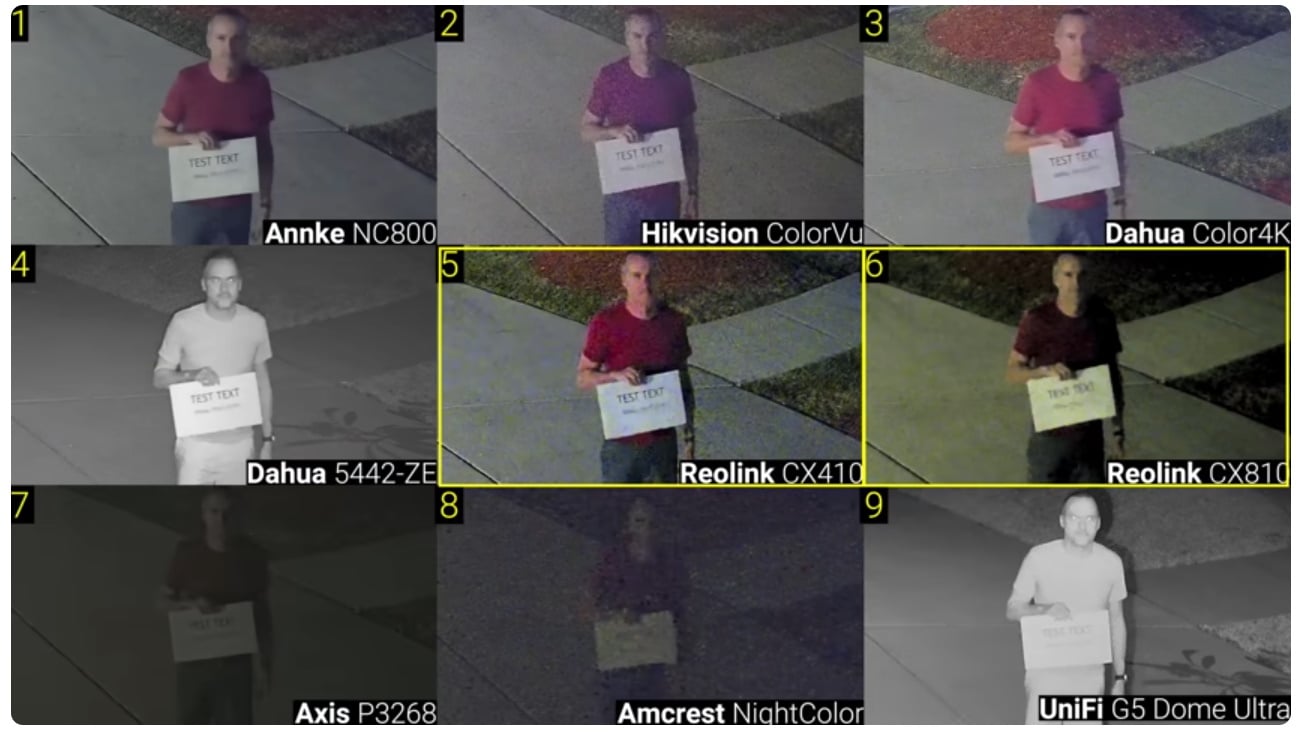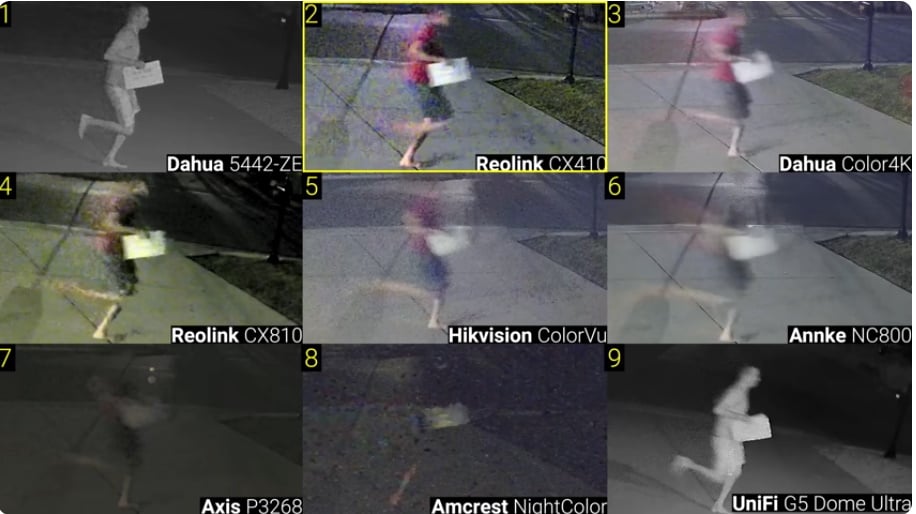It would be amazing if it doesn’t disintegrate if it rains, too.
Another vote for Reolink, especially the models with ONVIF support.
Dahua makes good stuff. Their products are commonly sold under different generic brand names too, but they’re all good
I’ve used a ton of ubiquity unifi cameras and they have a solid range on pricing. I think you need the unifi software to commission them though. For what it’s worth they don’t use the cloud for storage and don’t require any sort of subscription.
Ubiquity is the definition of vendor lock in.
Right. I only mentioned them because they don’t require a sub and you can store everything locally.
Regular IP cameras don’t require a sub and let you store everything locally (even to the point of a micro SD in the camera for backup).
Ubiquity cameras are ridiculously over priced for their quality. They charge $140 for a worse camera (image quality/ features) than a $40 ip camera that supports ONVIF so works with open source Linux NVR software.
This just isn’t true and I love an open source solution as much as the next guy but for ease of use, features and image quality you could do a lot worse. We use axis cameras where I work and they’re ridiculously over priced imo I understand that there are IP cameras that don’t require subs and have local storage but I offered my suggestion in case those were the major hold ups for OP.
Out of curiosity what’s a solid $40 outdoor IP camera with great image quality and features?
Hikvision has a $34 4 mp turret camera that outperforms the $130 2 MP Ubiquity in both dark and brightly lit environments. You can get them with color night vision or IR. Feature wise you can use them stand alone: you connect and control them with a web browser. You don’t need to buy anything else. They have built in motion detection and will save to a microsd card. I use an NVR, but it’s nice to have that feature if you are just getting started.
Same with Dahau. I like Hikvision for its web UI. But as I’ve already said, I don’t trust them and block their Mac/IP at the router. Ideally you want them on their own vlan.
Higher resolution doesn’t necessarily mean a better picture here. From what I can see in watching videos from this camera is that the bitrate is pretty low and the image is decent but not great. Without a doubt I get a better picture from a g3 flex and it’s tiny. It’s okay if you don’t like ubiquity hardware but it seems more like you just want to bash on ubiquity than actually make a fair comparison.
As I already said I have a lot of ubiquity hardware. I have a router, switch, and several wifi APs. I really want to go all Ubiquity for the convenience but their cameras are just bad at the same price as other products.
I’ve actually bought and compared them. I’ve had ip cameras in my home for almost 10 years now. I’ve tried many cameras over the years.
It’s not just my opinion, every review rates Ubiquity’s cameras low. You are paying for convenience of integration if you already have Ubiquity’s products.
But there is an option in the UniFi software to have the cameras output an RTSP stream. It’s not bad if you already have some UniFi gear.
Regular IP cameras support ONVIF so they can work with any software.
I have Unifi router, switch and wifi APs.
And Unifi Protect recently started supporting ONVIF so it’s an option.
I only have the indoor one, but Reolink is fine. Used it as a baby cam. No cloud bs, supports an rtsp stream. App has gone downhill, but due to rtsp I sort of don’t care.
Similar product, different experience: I tried their doorbell and found it to be way underpowered once I turned on ONVIF. Huge, expanding lag between real world and camera feed. 20fps max is very oof too, even if you are going to use their protocol and software. And it doesn’t work with physical chime boxes, so you have to use their plug-in chime or botch a converter together yourself.
Was really excited (trying to replace a nest doorbell) and then so, so disappointed once I got it. Their other cams might be fine but oof, the experience put me off.
Probably look to secondhand commercial stuff, anything with ONVIF support should be fine.
Picked up some domed outdoor Cisco IP6630s awhile back off eBay for cheap and while not the best image wise they’re built like tanks AND they give you full root access lol
The only outdoor camera I have is an Amcrest AD110 doorbell camera and it is ok. Has some network connectivity issues occasionally but a restart seems to fix them. I plan on eventually getting some Amcrest IP8M-T2599EW when my budget allows.
As far as indoor cameras I use 4332027115 and they work very well. Both the AD110 and my indoor cameras are in blue iris and home assistant.
I had one of these years ago. I used it as a baby monitor and got a full refund when I discovered that the camera had security issues that caused the whole internet to be able to watch, pan/tilt, talk back, etc to my (now ex wife) when she was breast feeding.
Anything that supports ONVIF. I like Hikvision for their quality, price, and web interface for setup. But don’t trust any IP camera. Make sure the Mac and or IP address is blocked at your router.
There are different night visions to pick from. There’s ir night vision and white led lit night vision. I prefer ir night vision because I don’t want visible led lights on all night. You get a better picture at night although its black and white.
However many color night vision cameras do really well without any light source at all. I tried both and it’s more of a preference so I can’t say which one will work for you.
Reconsider hikvision: they were recently dropped as an option for many organizations due to some new data leak, and removed from gov buildings in a number of countries.
That’s why I said don’t trust it and block them at your router.
As long as you block them at your router Hikvision and Dahau are much better than the other brands at the same price. I’ve tried 6 different brands. I’ve been slowly moving them to all Hikvision.
And that’s why you don’t let them contact the Internet.
Managing IoT risk is an easy no brainer if people bother to try.
you shouldn’t block them by MAC. you should put them on a VLAN dedicated to cams, with no route to the internet. only computer connected to it is your NVR
Yes vlan is best.
I have reolink and use them with my NAS. Been happy with them!
deleted by creator
Yes, this.
And prob not what op is looking for but I also have a bunch of esp32 cams, different PCBs and with different sensors/lenses.
They ain’t much but also cost like 3 monies with shipping (and is enough to eg normally recognise people etc).


I’ve had four cameras running for a few years, streaming over RTSP and powered over ethernet. Works well!
Is this something a complete novice could do, with reasonable effort and cost? If so would you be able to eli5, or point me in the direction of somewhere that does?
Ideally, for my current situation anyway, I’d like to set up a camera indoors by a window (with IR switched off and a proper mount) and be able to see what it sees from a device (phone pc or even dedicated pad if it helps with security) in the other room, and if it can also record and save the video locally for me to be able to access from the remote device, that’d be good too. Privacy and security of the data are top priority.
Every time I start looking in to it my brain gets completely overwhelmed by options and information and scrambles, and I have to back away 😑 I’d love for there to be a way to set this up that was near as straightforward as the privacy abusing options…
I self-host and dabble with this stuff. Im an engineer for more than a decade.
But I really struggled to find a solution that has a really high uptime with minimal maintenance. Ive set up some raspberry pi projects, including cams. Why would I want video to transfer to some company?
But the trade offs were significant. Every few weeks, there was a new problem. Maybe my router. Maybe my internet. Maybe the Pi. Maybe something else. Maybe it’s my VPN when I’m trying to dial into the network. Maybe it’s my phone app no longer seeing the device. Maybe a update broke it. Maybe God hated me that day.
After six months and spending 2-3 hours a month maintaining it, I burned out and just bought an off-the-shelf solution with a mobile app.
Of course, I only use it for security and it doesn’t exist in the house. It grosses me out, but it’s been two years of plug-and-play and just working without setup.
Argh, this is exactly the scenario that I’ve anticipated and has kept me away from similar (home automation as well).
That’s what I want, high reliability, local only storage, remote view of some kind, and minimal (ongoing) fuss. Sounds like you did not quite land on that if the thing you bought grosses you out? Or do you mean something different?
You nailed it!
What grosses me out is that to get all those features, I have to be okay with my video data potentially landing in the hands of some company using it train AI or something.
Eufy was caught recently doing that. (And it’s my current solution for remote home camera system)
It’s not too difficult, I figured it out and I eat crayons.
Here’s the software I use but there are other options: https://github.com/BreeeZe/rpos - That runs on the camera Pi and provides the video stream.
I use a Pi, a camera module like this https://www.raspberrypi.com/products/raspberry-pi-high-quality-camera/ and a suitable lens. You can get cheaper camera modules, IR modules, etc.
Also, something like this to power it: https://www.tp-link.com/us/business-networking/omada-switch-unmanaged/ds105gp/ You could just use a regular switch and power the Pi with a power adapter if that works better. My cameras are all ceiling mounted so having one cable for data and power made sense for me.
I use this to split the ethernet into power and data when it reaches the Pi: https://www.amazon.com/UCTRONICS-PoE-Splitter-USB-C-Compliant/dp/B087F4QCTR/ref=pd_lpo_d_sccl_2/130-2310467-3870744?pd_rd_w=l0O0u&content-id=amzn1.sym.4c8c52db-06f8-4e42-8e56-912796f2ea6c&pf_rd_p=4c8c52db-06f8-4e42-8e56-912796f2ea6c&pf_rd_r=TNA6SF008RVJ5A1Y5V97&pd_rd_wg=4ITEg&pd_rd_r=e6c424de-42a7-4d27-974f-3f129d2bdd02&pd_rd_i=B087F4QCTR&th=1
Then I have this running on a Linux VM to collect the camera feeds and display them in a web browser: https://github.com/motioneye-project/motioneye
You’ll also need a case, my solution was to buy a metal Pi case and mount the module onto that, feeding the ribbon cable back into the case.
If you decide to go ahead and need help, just ask.
Oh wow, thanks so much for all the info, I really appreciate it! I’m bookmarking you reply and all the links, but it’s a bit much for me to process right now lol (I saw your comment about pretty much what I want to set up and just had to ask, fully meaning to get in to it, but it’s been a long morning and my brain is now mush)
Just to give you an idea, I’ve never set up or even used a Pi or used Linux, I’ve done very basic pc building and troubleshooting, but have no programming knowledge, so when I said novice I meant it 😂 I’m mostly good at following directions as long as they’re clear. Are there any manuals that would tell me how to put all the different parts you mentioned together?
Just throwing this out there, but the problem you’re describing sounds like a good fit for an LLM I’ve been using for similar purposes, Claude.
I’ve found it to be really good at helping me slog through what would be a burdensome and wasteful amount of reading, in order to answer specific questions OR to get a baseline understanding of a thing.
It’s a bit hard to know how much value comes from my engineering background and my tendency to “know what I don’t know” and thereby ask focused questions, but it’s definitely worth a shot. I have found it to be surprisingly sophisticated and much better than slogging through the wasteland of bad search results + too much unrelated but real info.
A topic like this where there’s a tremendous amount of legit docs, articles, and forum activity - it’s really the exact use case where it’s very difficult for a human, and very easy for an LLM to effectively digest that info.
Some caveats I’ve noticed:
- it sometimes is overly agreeable / “friendly” when it should be more direct
- it does sometimes hallucinate or say BS with casual confidence, which sucks because the more you need the info the less well you can spot that. It hasn’t hampered usefulness too much for me, but then again I’m usually able to spot the mistakes even in ~unfamiliar subjects
- they’ve moved the free tier back to a less capable model at the moment…most of my good experiences are with Claude 3.5 Sonnet, but Claude 3 Haiku (present free tier) is still good
If you’re really curious but the volume of reading and documentation to get started is presenting a big barrier, try using Claude to see how quickly you might be able to clear that obstacle. It’s been removing those exact barriers for me very effectively lately.
Edit to add: a particularly useful way I can imagine folks in your shoes using this - as a “companion” while you try to follow a guide in an article somewhere. It can answer questions about terms you don’t understand, even reasoning behind doing certain steps or what to do if it goes wrong. In fact, you could almost certainly just feed it the written procedure itself (telling it that you’re doing so) and really get it to reason about the process with you. Just help get you through whatever implementation.
I genuinely appreciate you taking the time to make this comment, thanks.
I do see how this can be helpful for a lot of things, but I think in my situation (namely a bunch of neurodiversity and brain fog, and no existing interest in or experience with LLMs), having to learn how to deal with an LLM to a point where I get results I’d be confident enough in to trust without having to double or triple check, is probably a bigger hurdle than just diving in to figuring out security camera set ups. It’s putting one more thing in the way of the information I actually need, which means my brain is much much less motivated than it already is to get the information, if you see what I mean…
I do understand what you mean, but I think you’re probably significantly overestimating the difficulty of using the tool. One of its major strengths is its ability to just understand you, like you’d talk to anyone human, with the benefit that you can even instruct it to use a style you prefer. Just say “I’d like your answer to be terse, let’s see if we’re on the right track before getting into details”. Just as an example.
With all that said you know what you want and need better than anyone else, that’s all I’ve got to say on it, cheers!
There are plenty of guides but I just took it step by step. The links I provided have instructions for each bit of software needed. You’ll need to be able to do things like flash the OS to a SD or USB drive and then be able to ssh into the Pi to install the camera software. Start here: https://www.raspberrypi.com/software/
There’s no programming skill needed but you should be comfortable with using the terminal, or at least be willing to learn. You don’t need to install a OS with a desktop, everything is done via the terminal.
After that’s done you can use VLC to view the feed and check it’s working before installing motioneye on a server. You just get the IP address of the camera and give the URL to VLC like this: rtsp://xxx. xxx. xxx.xxx:8554/h264
If you look at the whole thing in one go, it’s overwhelming, but if you break it into chunks it’s not too bad and it’s a good learning opportunity, if that’s your thing.
If you look at the whole thing in one go, it’s overwhelming, but if you break it into chunks it’s not too bad and it’s a good learning opportunity, if that’s your thing.
This is very encouraging and helpful, I will try to keep it in mind! Do I just go in the order of the links you posted in the previous reply?
Also just to make sure I understand correctly - at the end of it I should have a camera setup that I can access, via VLC, from the device of my choosing over ethernet/intranet?
Thanks again for taking the time to talk me through this.
Do I just go in the order of the links you posted in the previous reply?
Yes. Get a working camera feed and go from there. For that, tackle the hardware side first - Pi, camera, power/ethernet, case, storage for the OS. Then install the OS and the camera software and test it. Mine are all indoors so you’ll have to see what kind of cases are weatherproof if you’re using it outside.
Also just to make sure I understand correctly - at the end of it I should have a camera setup that I can access, via VLC, from the device of my choosing over ethernet/intranet?
Exactly. VLC will be fine if you only want to view one camera. If you want to add more, do recording/motion detection, view them in a browser, etc. then MotionEye on a server works but there are other options. I know that the Synology NAS’ DSM OS has its own solution for managing all that stuff.
All my cameras are reolink. I have their duo2 which is super wide so it captures everything, I use the doorbells and have the 360 camera in my garage. They all work with frigate and blue iris.
I have this, and then block internet access at the router level. The app still works if on the internal network or wireguard vpn
Axis have some really good ones. Most of them support RTSP, and many have PTZ as a bonus.
Source: I’ve installed a lot of them onboard ships. Axis and Samsung are the ones that handle the environment best.
I use cheap and cheerful cameras with Ingenic SOCs and flash an open source firmware thingino on them.
List of supported cameras increases fairly rapidly
I’ve been looking for the same thing, everything usually points to frigate being the answer, but it seems like a bit of work to get everything set up.
I use amcrest with my nas
Just curious: why don’t you want night vision? The only time it isn’t useful is if the camera will be looking through a window, cause there’s too much glare when the ir lights are on.
Whoops, average English mistake. I meant that I want “no vendor lock in” and “night vision”
I figured, lol. But even native speakers can be ambiguous in their phrasing. You made an extremely common mistake, so don’t feel bad.












